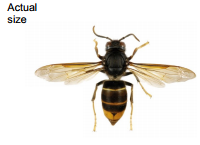Asian Hornet

Asian hornet Image: Non-native Species Secretariat
Vespa velutina or the Asian hornet, also known as the yellow legged hornet, is native to Asia. It was seen in Gloucestershire in September 2016, with the colony being found and destroyed. The hornet preys on honeybees. All beekeepers should remain vigillant and be on the look out for it in their apiaries.
Vespa velutina (Asian hornet) and Vespa crabro (European hornet) can be easily distinguished from each other. The Asian hornet is smaller than our native European hornet and has a black and yellow appearance which contrasts the brown and brownish yellow of V. crabro. Nests are founded by a single queen who rapidly starts laying eggs after building her nest in April. As the colony size increases through the summer, it will reach an average population of 6000 individuals and in July, hornets will begin predating on honey bee colonies; hornet brood requires animal proteins which are transformed into flesh pellets and then offered to the larvae. This hunting behaviour can continue well into the end of November. In autumn (around September), the nest will focus on the production of potential queens (on average 350) and male drones, who will mate with the queens. These mated queens will overwinter and leave the workers and males to die before winter. The following spring, the fertilised founder queens will begin the production of a new colony.
Monitoring for the Asian hornet
Firstly, make sure you know how to recognise Asian hornets – a very helpful ID sheet and poster is available for helping you to look out for the hornet: Click for an Asian hornet identification sheet
Deformed Wing Virus research
Researchers have tracked the spread of deformed wing virus (DWV) and found a link with the commercial movement of honey bees. Scientists used genetic analysis to characterise DWV and Varroa mites from 17 countries. Professor Stephen Martin of the University of Salford said, “It supports the idea that DWV is the main cause for the colony losses associated with Varroa and that this comes from European bees.” The researchers are calling for tighter controls and health checks during the import and export of honey bees.
For more detail, see this report on the BBC News web site: Spread of bee disease ‘largely manmade’
Image Credit: Klaas de Gelder
Creative Commons non-commercial